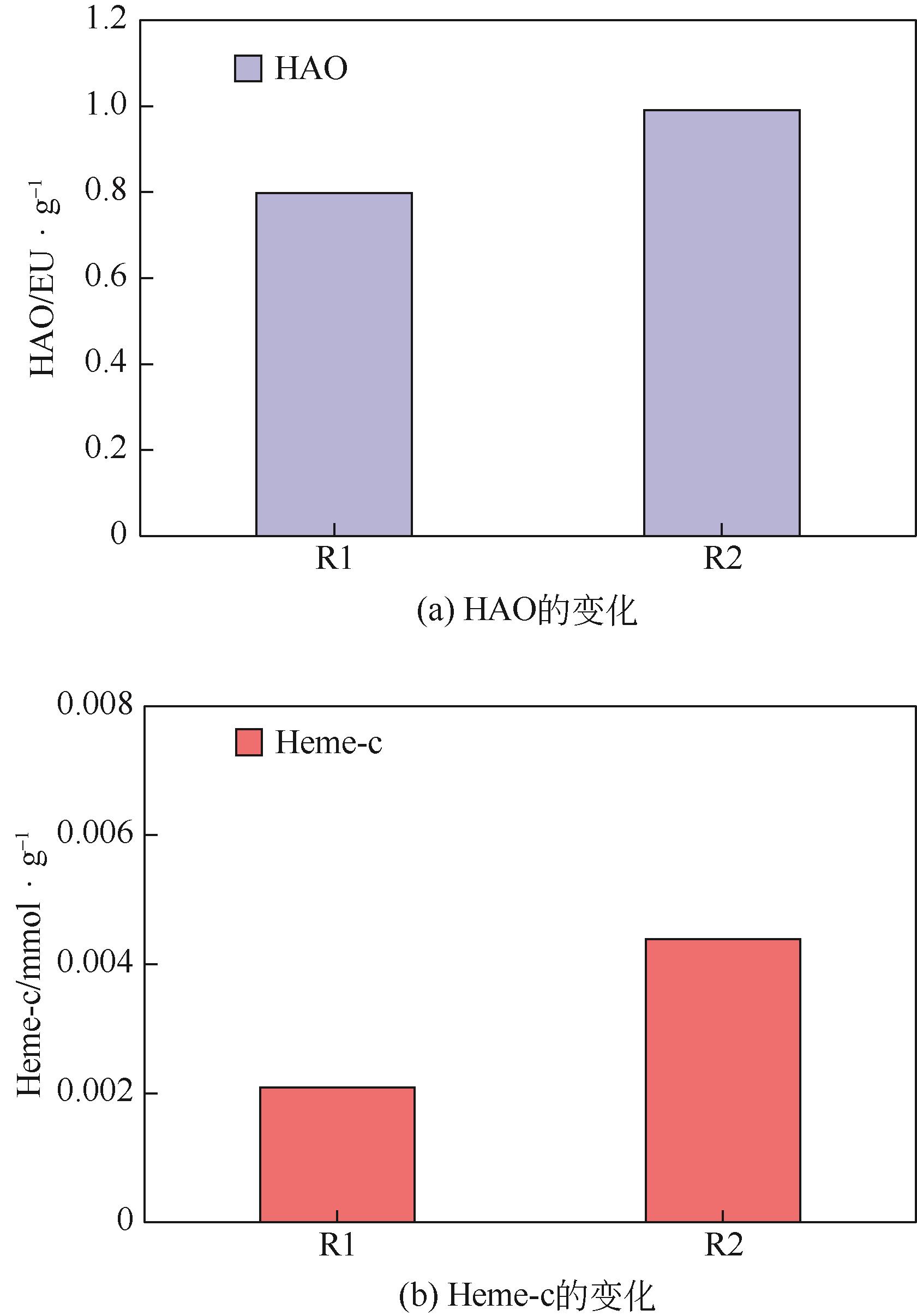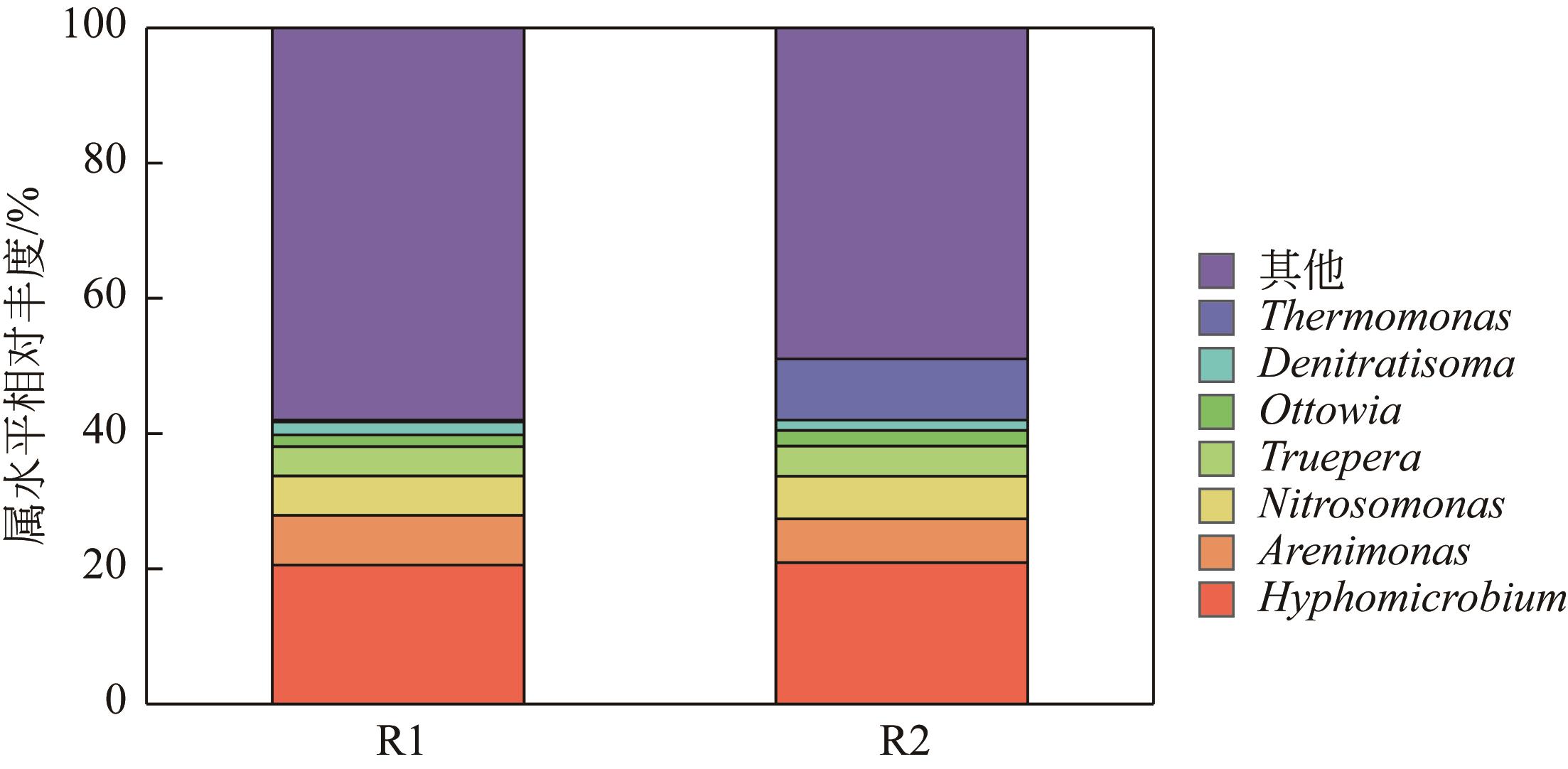| 1 |
杜世明, 于德爽, 毕春雪, 等. DPR-SNED系统处理低C/N城市污水与硝酸盐废水的运行特性[J]. 环境科学, 2019, 40(2): 791-798.
|
|
DU Shiming, YU Deshuang, BI Chunxue, et al. Operating characteristics of a DPR-SNED system treating low C/N municipal wastewater and nitrate-containing sewage[J]. Environmental Science, 2019, 40(2): 791-798.
|
| 2 |
方芳, 杨国红, 郭劲松, 等. DO和曝停比对单级自养脱氮工艺影响试验研究[J]. 环境科学, 2007, 28(9): 1975-1980.
|
|
FANG Fang, YANG Guohong, GUO Jinsong, et al. Influence of DO and aeration/non-aeration ratio on one-step SBBR completely autotrophic nitrogen removal process[J]. Environmental Science, 2007, 28(9): 1975-1980.
|
| 3 |
徐旻旸, 胡湛波, 张穗生, 等. 智能化曝气控制A/O工艺活性污泥特性演化对内源反硝化脱氮的作用机制[J]. 环境科学, 2018, 39(4): 1720-1730.
|
|
XU Minyang, HU Zhanbo, ZHANG Suisheng, et al. Mechanism of action of activated sludge properties in nitrogen removal by endogenous denitrification through an intelligent aeration-controlled A/O process[J]. Environmental Science, 2018, 39(4): 1720-1730.
|
| 4 |
王琪, 李冬, 李鹏垚, 等. 厌/缺氧时间对好氧颗粒污泥同步硝化内源反硝化和除磷的影响[J]. 中国环境科学, 2022, 42(9): 4199-4206.
|
|
WANG Qi, LI Dong, LI Pengyao, et al. Effects of anaerobic/anoxic time on simultaneous nitrification-endogenous denitrification and phosphorous removal from aerobic granular sludge[J]. China Environmental Science, 2022, 42(9): 4199-4206.
|
| 5 |
NI Bingjie, ZENG R J, FANG Fang, et al. Evaluation on factors influencing the heterotrophic growth on the soluble microbial products of autotrophs[J]. Biotechnology and Bioengineering, 2011, 108(4): 804-812.
|
| 6 |
崔有为, 金常林, 王好韩, 等. 碳源对O/A-F/F模式积累内源聚合物及反硝化的影响[J]. 环境科学, 2019, 40(1): 336-342.
|
|
CUI Youwei, JIN Changlin, WANG Haohan, et al. Effect of carbon sources on the accumulation of endogenous polymers and denitritation in the O/A-F/F mode[J]. Environmental Science, 2019, 40(1): 336-342.
|
| 7 |
LIU Yiwen, SUN Jing, PENG Lai, et al. Assessment of heterotrophic growth supported by soluble microbial products in anammox biofilm using multidimensional modeling[J]. Scientific Reports, 2016, 6(1): 1-11.
|
| 8 |
邱健, 贾振华, 李承光, 等. 细菌群体感应淬灭酶的研究进展[J]. 微生物学通报, 2006, 33(4): 139-143.
|
|
QIU Jian, JIA Zhenhua, LI Chenguang, et al. Advance on bacterial quorum-quenching enzymes[J]. Microbiology China, 2006, 33(4): 139-143.
|
| 9 |
崔雪燕. 群体感应对Pseudomonas aeruginosa反硝化的调控及其潜在应用分析[D]. 杭州: 浙江工商大学, 2018.
|
|
CUI Xueyan. The role of quorum sensing on the denitrification of Pseudomonas aeruginosa and its potential application[D]. Hangzhou: Zhejiang Gongshang University, 2018.
|
| 10 |
支丽玲. 群体感应及猝灭效应对好氧颗粒污泥系统的影响研究[D]. 无锡: 江南大学, 2020.
|
|
ZHI Liling. Effects of quorum sensing and quenching on aerobic granular sludge[D]. Wuxi: Jiangnan University, 2020.
|
| 11 |
LE BERRE R, NGUYEN S, NOWAK E, et al. Quorum-sensing activity and related virulence factor expression in clinically pathogenic isolates of Pseudomonas aeruginosa [J]. Clinical Microbiology and Infection, 2008, 14(4): 337-343.
|
| 12 |
YEON Kyung Min, CHEONG Won Seok, Hyun Suk OH, et al. Quorum sensing: A new biofouling control paradigm in a membrane bioreactor for advanced wastewater treatment[J]. Environmental Science & Technology, 2009, 43(2): 380-385.
|
| 13 |
KIM Jae Hyuk, CHOI Dong Chan, YEON Kyung Min, et al. Enzyme-immobilized nanofiltration membrane to mitigate biofouling based on quorum quenching[J]. Environmental Science & Technology, 2011, 45(4): 1601-1607.
|
| 14 |
ZHANG Xiaojing, ZHANG Nan, CHEN Zhao, et al. Long-term impact of sulfate on an autotrophic nitrogen removal system integrated partial nitrification, anammox and endogenous denitrification (PAED)[J]. Chemosphere, 2019, 235: 336-343.
|
| 15 |
CHEN Zhao, ZHANG Xiaojing, MA Yongpeng, et al. Anammox biofilm system under the stress of Hg( Ⅱ ): Nitrogen removal performance, microbial community dynamic and resistance genes expression[J]. Journal of Hazardous Materials, 2020, 395: 122665.
|
| 16 |
ZHANG Xiaojing, ZHOU Yue, YU Boyang, et al. Effect of copper oxide nanoparticles on the ammonia removal and microbial community of partial nitrification process[J]. Chemical Engineering Journal, 2017, 328: 152-158.
|
| 17 |
BERRY E A, TRUMPOWER B L. Simultaneous determination of hemes a, b, and c from pyridine hemochrome spectra[J]. Analytical Biochemistry, 1987, 161(1): 1-15.
|
| 18 |
阮心怡, 崔雪燕, 殷峻, 等. 群体感应在Pseudomonas aeruginosa生物强化反硝化中的应用研究[J]. 环境科学学报, 2020, 40(5): 1661-1666.
|
|
RUAN Xinyi, CUI Xueyan, YIN Jun, et al. Application of quorum sensing in bioaugmentation for denitrification process with Pseudomonas aeruginosa [J]. Acta Scientiae Circumstantiae, 2020, 40(5): 1661-1666.
|
| 19 |
张肖静, 张红丽, 张楠, 等. 群体感应淬灭酶对 MBR-CANON工艺脱氮性能及污泥特性的影响[J]. 轻工学报, 2022, 37(6): 110-118.
|
|
ZHANG Xiaojing, ZHANG Hongli, ZHANG Nan, et al. Effect of quorum quenching enzyme on the nitrogen removal performance and sludge property of MBR-CANON process[J]. Journal of Light Industry, 2022, 37(6): 110-118.
|
| 20 |
黄兴, 孙宝盛, 孙井梅, 等. 贫营养条件下EPS、SMP和微生物多样性的研究[J]. 环境科学, 2009, 30(5): 1468-1474.
|
|
HUANG Xing, SUN Baosheng, SUN Jingmei, et al. EPS, SMP and microbial biodiversity under the oligotrophic environment[J]. Environmental Science, 2009, 30(5): 1468-1474.
|
| 21 |
郑甜甜, 黄丹, 班允赫, 等. 群体感应抑制控制膜生物污染的研究进展[J]. 辽宁化工, 2013, 42(10): 1181-1184.
|
|
ZHENG Tiantian, HUANG Dan, BAN Yunhe, et al. Research progress in controlling membrane biological fouling by quorum sensing system[J]. Liaoning Chemical Industry, 2013, 42(10): 1181-1184.
|
| 22 |
李松亚. 微生物群落与群体感应对活性污泥系统运行协同关系研究[D]. 天津: 天津大学, 2020.
|
|
LI Songya. Research on cooperative relationship between microbial community and quorum sensing on performance of activated sludge[D]. Tianjin: Tianjin University, 2020.
|
| 23 |
张雪宁. 可溶性微生物产物的产生及其对反硝化的影响研究[D]. 哈尔滨: 哈尔滨工业大学, 2014.
|
|
ZHANG Xuening. Research on production of soluble microbial products and its effect on denitrification[D]. Harbin: Harbin Institute of Technology, 2014.
|
| 24 |
凌欣, 徐慧平, 陆光华. 两种PPCPs对雅鲁藏布江沉积物硝化作用的影响[J]. 环境科学, 2021, 42(6): 2868-2874.
|
|
LING X, XU H P, LU G H. Effects of two PPCPs on nitrification in sediments in the Yarlung Zangbo River[J]. Environmental Science, 2021, 42(6): 2868-2874.
|
| 25 |
吴启凤, 丁晨雨, 何腾霞, 等. 羟胺氧化还原酶在生物脱氮中的研究进展[J]. 微生物学通报, 2022, 49(3): 1120-1134.
|
|
WU Qifeng, DING Chenyu, HE Tengxia, et al. Research progress of hydroxylamine oxidoreductase in biological denitrification[J]. Microbiology China, 2022, 49 (3): 1120-1134.
|
| 26 |
赵弋戈, 郑平. 厌氧氨氧化体的组成、结构与功能[J]. 微生物学报, 2016, 56(1): 8-18.
|
|
ZHAO Yige, ZHENG Ping. Composition, structure and function of anammoxosome—A review[J]. Acta Microbiologica Sinica, 2016, 56 (1): 8-18.
|
| 27 |
WU Dan, ZHANG Quan, XIA Wenjing, et al. Effect of divalent nickel on the anammox process in a UASB reactor[J]. Chemosphere, 2019, 226: 934-944.
|
| 28 |
蔡靖, 郑平. 亚硝酸盐型同步厌氧生物脱氮除硫工艺的运行性能[J]. 生物工程学报, 2009, 25(11): 1684-1689.
|
|
CAI Jing, ZHENG Ping. Simultaneous removal of sulfide and nitrite by anaerobic bioprocess[J]. Chinese Journal of Biotechnology, 2009, 25(11): 1684-1689.
|
| 29 |
陈红玲, 张兴桃, 王晴, 等. 宏基因组方法分析医药化工废水厂中抗生素耐药菌及耐性基因[J]. 环境科学, 2020, 41(1): 313-320.
|
|
CHEN Hongling, ZHANG Xingtao, WANG Qing, et al. Metagenomic analysis of antibiotic resistant bacteria and resistance genes in a pharmaceutical and chemical wastewater treatment plant[J]. Environmental Science, 2020, 41(1): 313-320.
|
| 30 |
古柏铭, 金春姬, 温淳, 等. 提盐速率对序批式生物反应器性能和微生物群落结构的影响[J]. 环境科学, 2021, 42(7): 3413-3421.
|
|
GU Baiming, JIN Chunji, WEN Chun, et al. Effect of rate of salinity increase on the performance and microbial community structure of sequencing batch reactors[J]. Environmental Science, 2021, 42(7): 3413-3421.
|
| 31 |
任省涛, 郭夏丽, 芦阿虔, 等. 林可霉素菌渣堆肥微生物群落多样性分析[J]. 环境科学, 2018, 39(10): 4817-4824.
|
|
REN Shengtao, GUO Xiali, LU Aqian, et al. Microbial community diversity analysis during composting of lincomycin mycelia dreg with manure[J]. Environmental Science, 2018, 39(10): 4817-4824.
|
| 32 |
高晨晨, 游佳, 陈轶, 等. 丝状菌污泥膨胀对脱氮除磷功能菌群的影响[J]. 环境科学, 2018, 39(6): 2794-2801.
|
|
GAO Chenchen, YOU Jia, CHEN Yi, et al. Effect of denitrification and phosphorus removal microorganisms in activated sludge bulking caused by filamentous bacteria[J]. Environmental Science, 2018, 39(6): 2794-2801.
|
| 33 |
ZHANG Zhengwen, HAN Yuxing, XU Chunyan, et al. Effect of low-intensity direct current electric field on microbial nitrate removal in coal pyrolysis wastewater with low COD to nitrogen ratio[J]. Bioresource Technology, 2019, 287: 121465.
|
| 34 |
陈瑞. 厌氧氨氧化反应器脱氮微生物群落结构研究[D]. 乌鲁木齐: 新疆大学, 2019.
|
|
CHEN Rui. Study on nitrogen-removing microbial community structures in the anammox reactor[D]. Urumqi: Xinjiang University, 2019.
|
| 35 |
FANG Yingke, WANG Hongcheng, HAN Jinglong, et al. Enhanced nitrogen removal of constructed wetlands by coupling with the bioelectrochemical system under low temperature: Performance and mechanism[J]. Journal of Cleaner Production, 2022, 350: 131365.
|
| 36 |
WANG Jun, LEI Zhen, WANG Lianxu, et al. Insight into using up-flow anaerobic sludge blanket-anammox to remove nitrogen from an anaerobic membrane reactor during mainstream wastewater treatment[J]. Bioresource Technology, 2020, 314: 123710.
|
 ), 张肖静(
), 张肖静( ), 张楠, 马冰冰, 张涵, 杨浩洁, 张宏忠
), 张楠, 马冰冰, 张涵, 杨浩洁, 张宏忠
 ), ZHANG Xiaojing(
), ZHANG Xiaojing( ), ZHANG Nan, MA Bingbing, ZHANG Han, YANG Haojie, ZHANG Hongzhong
), ZHANG Nan, MA Bingbing, ZHANG Han, YANG Haojie, ZHANG Hongzhong



